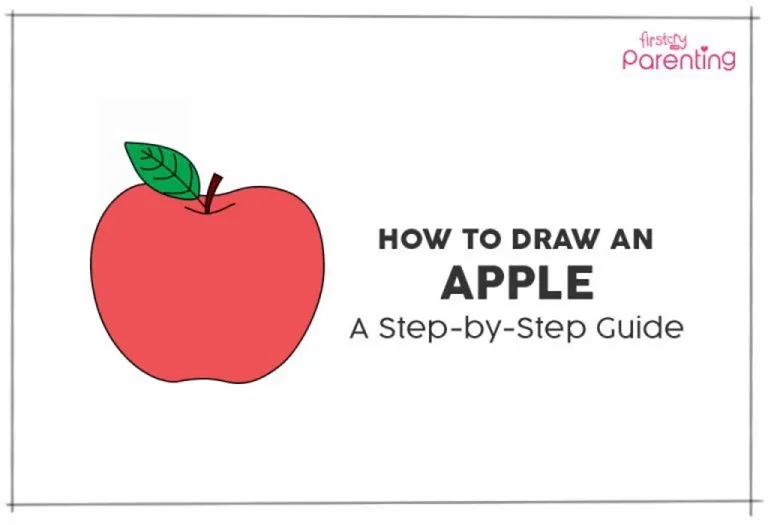How to Draw An Apple for Kids
- What You Will Need to Draw an Apple?
- Apple Drawing for Kids in 8 Simple Steps
- What Are the Benefits of Learning to Draw an Apple for Children?
- FAQs
An apple a day keeps a doctor away. The fruit has been a part of your child’s diet since was a little baby. Remember all the apple puree you fed your little munchkin while weaning? Now that your baby is old enough to chomp on and relish slices of the fruit to her heart’s content, let’s use the fruit as a subject and teach your child how to draw an apple, step by step.
Encouraging your child’s creativity through drawing not only fosters artistic skills but also enhances cognitive development. Engaging in such activities not only sparks your child’s imagination but also provides an opportunity to discuss the importance of a balanced diet and the health benefits of consuming fruits like apples. Take this chance to bond with your little one through art and valuable conversations. Read on for easy instructions to draw an apple.
What You Will Need to Draw an Apple?
- A drawing paper
- Red, green and brown paint/ crayons/ sketch pens
- A black-coloured sketch pen
- A pencil
- An eraser
- A circular lid (3 to 5-inch diameter or of your preferred size)
Apple Drawing for Kids in 8 Simple Steps
Here’s an easy guide on how to draw an apple, step-by-step.
Step 1: Draw a Circle
Using a pencil, draw a circle with the help of the circular lid. We’ve given a size specification, but you can choose to draw your apple as big or small as you want. You can also go free-hand with the circle.

Step 2: Draw a Wave in the Top Half Part of the Circle
Leave some distance from the top of the circle, and draw a wave-like pattern that dips in the centre as shown in the figure below. This dip/ trough is where we will draw a stalk later. Let the ends of the wave overlap the circle on each side. It should look like a hairline on a face.

Step 3: Draw a Wave in the Bottom of the Circle
Draw another wave-like pattern at the bottom of the circle with its centre raised, as shown in the figure. Once again, let the ends of the wave overlap with the sides of the circle. The bottom curve is where the stamen of the apple is located. The drawing now probably looks like someone wearing an oversized pair of glasses, but it actually is the body of the fruit. Easy to draw, right?

Step 4: Draw a Small Curve Under the Top Wave-Like Pattern
Just under the top wave pattern, draw a curve underneath the gentle trough, as shown in the figure.

Step 5: Draw a Stalk and a Leaf
Draw two slightly curved lines projecting upward from the centre of the small curve you’ve just drawn. Join the ends of these lines. There, you have the stalk! It should look like a gently sloping elongated triangle.
Now, draw a leaf from the left base of the stalk, as shown in the figure. An easy way to draw a leaf is to draw a line projecting outwards from the base of the stalk and then draw an oval-shaped blade around it.
If you’re keen on learning how to draw different types of leaves, do leave a comment below.

Step 6: Draw the Veins of the Leaf
Now, on the leaf, draw slightly curved lines projecting out from the centre line. These are the veins of the leaf.

Step 7: Final Touches
Now, erase the unwanted lines and, with a black sketch pen, outline the apple.

Step 8: Paint It Red!
Colour the apple in a vibrant red colour. Use green for the leaf and brown for the stalk.

What Are the Benefits of Learning to Draw an Apple for Children?
Learning the drawing of an apple can offer numerous benefits for children, encompassing both artistic and educational aspects. As they engage in the creative process of drawing, children develop essential motor skills and cognitive abilities. Here are some specific benefits:
- Fine Motor Skills Enhancement: Drawing involves precise hand movements, contributing to the refinement of fine motor skills in children.
- Cognitive Development: The process of visualizing and replicating an object on paper enhances cognitive abilities and spatial awareness.
- Creativity and Imagination Boost: Drawing encourages creative thinking and allows children to express their imagination freely through art.
- Educational Engagement: Using a familiar object like an apple turns the drawing activity into an educational experience, providing an opportunity to discuss topics like nutrition and healthy eating habits.
FAQs
1. What Age Is Suitable for this Drawing Activity?
This drawing activity is suitable for children of various ages, but it is often recommended for kids around 4 years old and above. Younger children may need more assistance, while older kids can enjoy it independently.
2. How to Make My Apple Look More Realistic?
To make your apple look more realistic, focus on shading and texture. Add shadows to create depth, and consider using different shades of color. Pay attention to details like the stem and leaf, and observe real apples for inspiration.
3. What Other Fruits Can I Teach My Child to Draw?
Expand your child’s artistic skills by teaching them to draw various fruits. Start with simple shapes and gradually add details. Some other fruits to consider include bananas, oranges, strawberries, and grapes. Use a step-by-step approach to make it fun and easy for your child to learn.
There you have it! With this step-by-step, easy-to-draw apple guide, you can teach your tiny tot how to draw an apple! Let your munchkin draw as many apples as they want and show them off to your friends and family. Don’t forget to reward your kiddo with one of some delicious apple recipes. The apple of your eye deserves it!
Also Read:
How to Teach Kids to Draw?
How to Draw a Lion for Kids?
How to Draw a Butterfly for Children?
How to Draw a Christmas Tree for Kids























